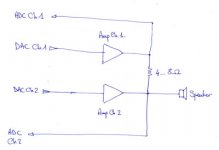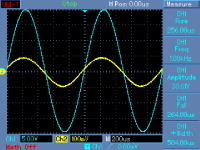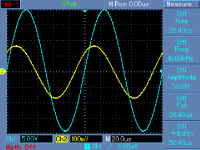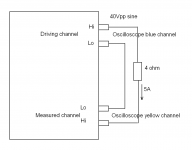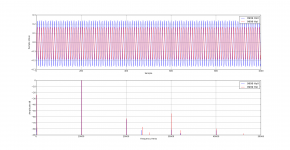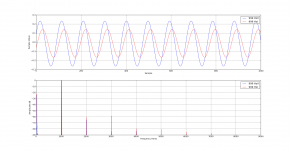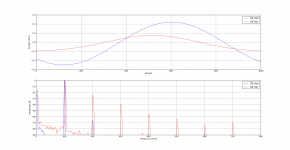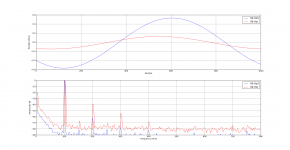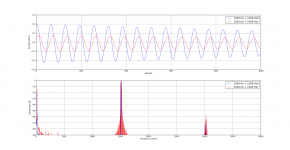Karl, I understand where your comments are coming from, and I sympathise with your sentiments. However, and it's a big however 🙂, there is green grass on the other side, on the side of achieving the highest levels of accuracy. No pain, no gain is the simplistic expression - and it does fit to some degree in getting the best from audio.
That fatiguing, artificial quality, to 'accurate' sound, is a manifestion of how it often comes across when the sound is 95% on the way to 'being there' - and it will remain so until you hit the 100% marker. Having gone this journey over and over and over again, through many years, I know this well-worn path like the proverbial back of my ...
It's always been worthwhile persisting with accurate sound, because the reward, when it comes, is quite overwhelming, and immensely satisfying!
Just letting you know ... 😉
🙂 In the end it comes down to personal preference for the type of sound each listener is after.
May I ask what your reference system consists of, your speakers, amp and source components ?
I can't rationally argue against the perfect amplifier, the piece of wire with gain... all I can say is that having owned a couple of amps that probably came very close to that goal, and having listened to many more, its not a final result I enjoy listening too.
Of course it's a personal preference in the end - it has to be something that you enjoy living with, on an ongoing basis, 🙂.
Reference system? No such animal, merely any system with sufficient, audible weaknesses eradicated. Because it entails the entirety of the system, all the components working as a single entity to produce sound it's hard to give a simple formula ... Lately, I've been listening to all sorts of bits and pieces, because I'm interested in the process of tweaking itself, as a means to an end - I get satisfaction from realising the potential in a bit of gear that most would completely ignore, as having any potential for decent sound ...
My most recent experiences have indicated that the best chances of getting an off the shelf solution are via music server, well engineered, 'over-powered' amps, like Bryston, and competent, reasonably efficient speakers.
Reference system? No such animal, merely any system with sufficient, audible weaknesses eradicated. Because it entails the entirety of the system, all the components working as a single entity to produce sound it's hard to give a simple formula ... Lately, I've been listening to all sorts of bits and pieces, because I'm interested in the process of tweaking itself, as a means to an end - I get satisfaction from realising the potential in a bit of gear that most would completely ignore, as having any potential for decent sound ...
My most recent experiences have indicated that the best chances of getting an off the shelf solution are via music server, well engineered, 'over-powered' amps, like Bryston, and competent, reasonably efficient speakers.
Last edited:
😀 So no reference system. Hmmm.... thats a diplomatic answer Frank 🙂
I've lived with my current amp for the last 8 years or so. Sound quality wise it never fails to impress, with pretty much any material, even substandard stuff like DAB radio at less than ideal bit rates (MPEG 1 @ 160kbs for instance). There is an audible quality that shines through. I sat for years with other gear trying to convince myself it was correct.
That said, the diy bug bites and I want to design a new amp, but it will take the present amp as a starting point sound quality wise and probably topology wise too. Its just something I believe in, and moreover I have faith and confidence in my design/s. For me they give long term listening enjoyment.
🙂 (I think I'm beginning to understand how JC feels sometimes lol)
I've lived with my current amp for the last 8 years or so. Sound quality wise it never fails to impress, with pretty much any material, even substandard stuff like DAB radio at less than ideal bit rates (MPEG 1 @ 160kbs for instance). There is an audible quality that shines through. I sat for years with other gear trying to convince myself it was correct.
That said, the diy bug bites and I want to design a new amp, but it will take the present amp as a starting point sound quality wise and probably topology wise too. Its just something I believe in, and moreover I have faith and confidence in my design/s. For me they give long term listening enjoyment.
🙂 (I think I'm beginning to understand how JC feels sometimes lol)
Karl, I can only say that my system sounds very pleasing to my ears (no fatigue), and it has very good reviews from my visitors. The power amp sounds quite different than D. Self's topology.
CD is Marantz SA7001
Preamp as here: PRE3 complementary-differential preamplifier
Power amp as here: PA4 power amplifier
3 way Quadral speaker (2 x bass, 1 x middle, 1 x tweeter)
CD is Marantz SA7001
Preamp as here: PRE3 complementary-differential preamplifier
Power amp as here: PA4 power amplifier
3 way Quadral speaker (2 x bass, 1 x middle, 1 x tweeter)
Actually, I just realised what I should have said was that I have reference CDs, rather than a system - these are 'difficult' recordings, where I know what the sound is capable of being projected as, for a system in ideal tune. Things like extremely compressed, very dense mixes, enormous soundstages, very primitive recording techniques -- these tell an enormous amount about a system ...
An apology now to Pavel - his latest test track is baby food in terms of usefulness in testing gear; after listening to the posted versions I switched to Southern State Sounds, from '93 - high energy, dense, heavily studio processed R 'n' B - and last step up was 2013 Iggy Pop - compression at the 99% setting - this instantly pinpointed where some more fine tuning could be done ...
An apology now to Pavel - his latest test track is baby food in terms of usefulness in testing gear; after listening to the posted versions I switched to Southern State Sounds, from '93 - high energy, dense, heavily studio processed R 'n' B - and last step up was 2013 Iggy Pop - compression at the 99% setting - this instantly pinpointed where some more fine tuning could be done ...
Frank, for serious listening tests, I use good recordings of classical music. For a web test and for having fun like here (it is all it is), I think that Barb Jungr's track that I used is fine. It has transients, it has voice, we can distinguish sounds from noise background easily (and failures on S/N can be easily heard), it has bass, it has attack and it has dynamics. Overcompressed roar might be good to test what you get at home, but not for a web test. Overcompressed roar does not test for accuracy and resolution, but rather for 'politeness'. For such purposes, I use Rolling Stones track "Flip the switch" from "Bridges to Babylon". Try it, it has at least certain quality.
Karl, I can only say that my system sounds very pleasing to my ears (no fatigue), and it has very good reviews from my visitors. The power amp sounds quite different than D. Self's topology.
CD is Marantz SA7001
Preamp as here: PRE3 complementary-differential preamplifier
Power amp as here: PA4 power amplifier
3 way Quadral speaker (2 x bass, 1 x middle, 1 x tweeter)
Nice set up Pavel 🙂 and I wouldn't imagine anything less really. I'm sure it does all that you say. Audio like everything else is a very personal choice, in the way a musician prefers one instrument over another... there are no right and wrongs.
If we can honestly say we are happy with what we have, having made that choice through listening to other equipment and set ups, then that is all that matters ultimately.
Pavel, I have no dispute with the posted track for this web exercise, 🙂 - but for what concerns me, which is the ability for a system to resolve fine detail when stressed the tracks I mentioned do an excellent job. What one focuses on is the quality of the vocals, the realism, and naturalness of that - when everywhere else the sound is exploding with energy, or volume. Because we all know what the human voice is like, really like, this is a dead giveaway, every time - on the Iggy recording his vocals are very natural - easy to hear this at low volumes - and as the volume increases this natural quality starts to degenerate as the amplifier begins to stress, from the heavily compressed instrumentals putting high demands on the power supply. When you've done exactly what's required to give the amplifier the best chance of behaving well, you immediately hear the improvement in the rendition of the voice.Frank, for serious listening tests, I use good recordings of classical music. For a web test and for having fun like here (it is all it is), I think that Barb Jungr's track that I used is fine. It has transients, it has voice, we can distinguish sounds from noise background easily (and failures on S/N can be easily heard), it has bass, it has attack and it has dynamics. Overcompressed roar might be good to test what you get at home, but not for a web test. Overcompressed roar does not test for accuracy and resolution, but rather for 'politeness'. For such purposes, I use Rolling Stones track "Flip the switch" from "Bridges to Babylon". Try it, it has at least certain quality.
Since you guys seem to be interested by what happens in the output stage of the amplifier, here is a test suggestion.
Amp1 drives a current (through resistor) into Amp2's output.
Amp2 tries to keep its output voltage at 0V.
Measuring the voltage at Amp2's output therefore gives its output impedance.
A speaker can be connected to hear the signal. However, with no speaker connected, current will flow straight between the positive and negative supplies, without going through ground... potentially less problems with ground currents then.
I'll try to do this tonight.
Amp1 drives a current (through resistor) into Amp2's output.
Amp2 tries to keep its output voltage at 0V.
Measuring the voltage at Amp2's output therefore gives its output impedance.
A speaker can be connected to hear the signal. However, with no speaker connected, current will flow straight between the positive and negative supplies, without going through ground... potentially less problems with ground currents then.
I'll try to do this tonight.
Attachments
Since you guys seem to be interested by what happens in the output stage of the amplifier, here is a test suggestion.
Amp1 drives a current (through resistor) into Amp2's output.
Amp2 tries to keep its output voltage at 0V.
Measuring the voltage at Amp2's output therefore gives its output impedance.
Hi pefeu, I do exactly the same thing, as a rule of thumb. From left channel I drive the right channel (or vice versa). As the power amplifier is dual mono with separate transformers, it can be done very easily.
Measurements at 1kHz and 10kHz are attached. The drive current is 5A.
But this arrangement measures as well a voltage drop on resistance and inductance (--> phase shift between waveforms) of the wires from PCB to speaker binding posts that are placed on the rear panel of the amplifier. Then, you can also imagine that wires from binding posts to speaker must be taken into account as well.
Attachments
Last edited:
It is also interesting to make a FFT of the residual (yellow trace). You would not like to see nastiness of class B switching here, crossover distortion. I consider this test as one of the most valuables, for a real amplifier design. This test also shows how linear is your output impedance.
Monster heat sinks 😉
How much bias are you using ?
I made a measurement of loudspeaker current and voltage (using my soundcard, 0.5 ohm resistor for current, and divider for voltage) at various frequencies and amplitudes.
Top graph are waveforms of current and voltage. Y-axis is float sample value (-1 .. 1). Don't look at the relative amplitudes of Current and voltage since I used the resistors that came first from my parts bin to make the attenuator...
Bottom graph is FFT. Both current and voltage are normalized so that the actual signal peaks are at 0dB, so the distortion relative to signal can be read directly on the dB axis. The current FFT is shifted a few pixels to the right for readability.
I think the measurements were done at 0.1, 0.4 and 2.8V, according to my multimeter, which I used on the 100 Hz test. It should be reasonably accurate.
I did not go further on the volts since it was already extremely loud even with the ear protection I use for the hammer drill... These loudspeakers are my desk ones, not the ones from the living room, they are pretty good and efficient. I've used the scope to measure the peak voltage on normal (ie, loud) music listening, with compressed music 0.1W is loud, with uncompressed drums a few watts peak give a nice feeling.
On the 2.83V test at 100Hz the desk was vibrating a lot...
Anyway. So, the loudspeaker current has a large amount of distortion... especially at "high" power (1W, lol).
It is reasonable to assume that this distorted current, combined with the impedance of cables and amplifier output, will create a distorted voltage at the loudspeakers terminals, and the tweeter will happily reproduce the harmonics of the woofer current.
So, that could explain why some like bi-wiring, although the theoretical effects should be non-existent...
I also like the last test (intermodulation between two very close frequencies)...
How much bias are you using ?
I made a measurement of loudspeaker current and voltage (using my soundcard, 0.5 ohm resistor for current, and divider for voltage) at various frequencies and amplitudes.
Top graph are waveforms of current and voltage. Y-axis is float sample value (-1 .. 1). Don't look at the relative amplitudes of Current and voltage since I used the resistors that came first from my parts bin to make the attenuator...
Bottom graph is FFT. Both current and voltage are normalized so that the actual signal peaks are at 0dB, so the distortion relative to signal can be read directly on the dB axis. The current FFT is shifted a few pixels to the right for readability.
I think the measurements were done at 0.1, 0.4 and 2.8V, according to my multimeter, which I used on the 100 Hz test. It should be reasonably accurate.
I did not go further on the volts since it was already extremely loud even with the ear protection I use for the hammer drill... These loudspeakers are my desk ones, not the ones from the living room, they are pretty good and efficient. I've used the scope to measure the peak voltage on normal (ie, loud) music listening, with compressed music 0.1W is loud, with uncompressed drums a few watts peak give a nice feeling.
On the 2.83V test at 100Hz the desk was vibrating a lot...
Anyway. So, the loudspeaker current has a large amount of distortion... especially at "high" power (1W, lol).
It is reasonable to assume that this distorted current, combined with the impedance of cables and amplifier output, will create a distorted voltage at the loudspeakers terminals, and the tweeter will happily reproduce the harmonics of the woofer current.
So, that could explain why some like bi-wiring, although the theoretical effects should be non-existent...
I also like the last test (intermodulation between two very close frequencies)...
Attachments
Last edited:
Bias current for output stage is about 270mA (67.5mA per pair), which makes about 32W idle power (output stage only) per channel. Originally it was biased at some 450mA, but the case was getting too hot.
@ Mooly
Nice idea for a test 🙂 The last link in the chain !
I wonder what the tests would reveal with speakers utilising Conjugate Load Matching, as in for eg some of KEF's designs ? I expect they would be kinder.
Nice idea for a test 🙂 The last link in the chain !
I wonder what the tests would reveal with speakers utilising Conjugate Load Matching, as in for eg some of KEF's designs ? I expect they would be kinder.
Thanks 🙂 It was different and a bit of fun. I would think anything that makes that the load appear more "resistive" is sure to reflect in better measurements.
Thanks 🙂 It was different and a bit of fun. I would think anything that makes that the load appear more "resistive" is sure to reflect in better measurements.
Karl, this is highly questionable. Again, measurements are quite easy to perform with dummy load and even with real speaker. The low ohmic load, a result of impedance equalized to resistive, does not automatically mean lower distortion. Opposite is true usually.
- Status
- Not open for further replies.
- Home
- General Interest
- Everything Else
- Listening Test... A Practical Demonstration That Amplifiers Have Their Own Sound.
